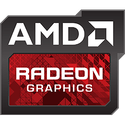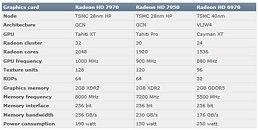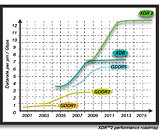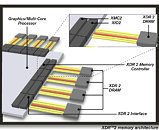Monday, September 12th 2011

Radeon HD 7900 Series to Use XDR2 Memory?
AMD's next-generation enthusiast graphics processor (GPU) is shaping up to be something more unique than expected. The GPU codenamed "Tahiti" is going to be bleeding-edge in terms of its feature-set. To begin with, there's talk that it will make use of PCI-Express Generation 3 (Gen 3) system bus, which will give it a mammoth 32 GB/s of system interface bandwidth. Next, Tahiti will use a number-crunching architecture that's a generation ahead of even the VLIW4 it released with Cayman. VLIW4 will make up for most of the HD 7000 series, but not the top-end Tahiti GPU, it will use what AMD is referring to as "CoreNext Architecture", which is expected to boost performance per square millimeter die area beyond even what VLIW4 manages.
The most recent piece of information is bound to shock and awe. Tahiti, it appears, will use the XDR2 memory interface. XDR2 is an ultra-high bandwidth and power-efficient memory bus that's competitive with GDDR5, maintained by Rambus, which is claimed by it to be a generation ahead of GDDR5. It's not like XDR2 will be exotic to AIBs, the XDR architecture is used in game consoles where the high-bandwidth offsets low memory capacity by allowing quick streaming of texture data. Rambus licenses XDR memory chip manufacture to notable high-volume vendors. Nordic Hardware compiled data from various unreliable sources to sketch out what Radeon HD 7900 series could look like.
Source:
NordicHardware
The most recent piece of information is bound to shock and awe. Tahiti, it appears, will use the XDR2 memory interface. XDR2 is an ultra-high bandwidth and power-efficient memory bus that's competitive with GDDR5, maintained by Rambus, which is claimed by it to be a generation ahead of GDDR5. It's not like XDR2 will be exotic to AIBs, the XDR architecture is used in game consoles where the high-bandwidth offsets low memory capacity by allowing quick streaming of texture data. Rambus licenses XDR memory chip manufacture to notable high-volume vendors. Nordic Hardware compiled data from various unreliable sources to sketch out what Radeon HD 7900 series could look like.



54 Comments on Radeon HD 7900 Series to Use XDR2 Memory?
:respect::respect:
Good design wins out every time, it might not be that funny car that goes the fastest, but it also doesn't cost as much, and take as much in maintenance.
EDIT: And maybe I'm completely wrong but didn't IBM have a lot of troubles getting Cell past some clocks due to the memory controller? I think I remember reading something about that.
I have no idea what kind of bus is needed for XDR2 RAM. It seems like some pretty nice stuff though.
Price + performance = sale or no sale for me.
7970 looks acceptable, performance would definitely be nicer they just need to think "build for laptop and unlock extra's for desktop" = 1x gpu solution with multiple applications. :toast:
It is nice now that the gpu's is starting to enter the 21st century where they should have been 5+ years ago or equivalent to 1000years in pc time.
Seems like the new leadership at AMD is finally paying off for ATI as well. :rockout:
R9700 still handles some games but fully supports Win 7 and Vista Aero desktops to max potential.
heh... rambus. they'd better be careful lest they get sued later.
I´m not a deep expert on technology but taking an overview i noted that AMD processors and AMD Graphics has the little disadvantege regarding memory bandwidth becasue if we take a little bit deeper all benchmarks developed with several efforts for many people on this page and anothers, you will note that nVidia and Intel uses on their architecture a biger memory bus band width, and if we make and a projection of performance will increase (theoric) on AMD processors and AMD Graphics, in other words AMD could be deliver a little bit of more performance about 20% to 30% more than actual performance tilting balance on your favor if they usess a biger memory bandwidth, is not a deep commentary but i think that the bottle neck on AMD units is the memory bus bandwidth on their units because if you note nVidia actually uses less clock frecuencies with a memory bus bandwidth of 384 bits, and Intel uses a bus clock of 3000Mhz instead of AMD uses on your high end GPUS´s 256bits with higer clock speeds of memory bus speed and 2000Mhz of bus clock on processors. And if AMD does not look it bottle neck on new architecture will ever have the disadvantage against its competitors. This just if you try to pump or make flow a certain amount of water trough a 1 square inch or and a hald sauare inch in what will be more faster the flow.. obiously trough the biger. Hope thar example coul be fine.
GDDR5 is power hungry to operate which is why GDDR3 is a better fit for optimus-type setups as the memory is always active.
so there's no need for 512 bit XDR2 either. ;)